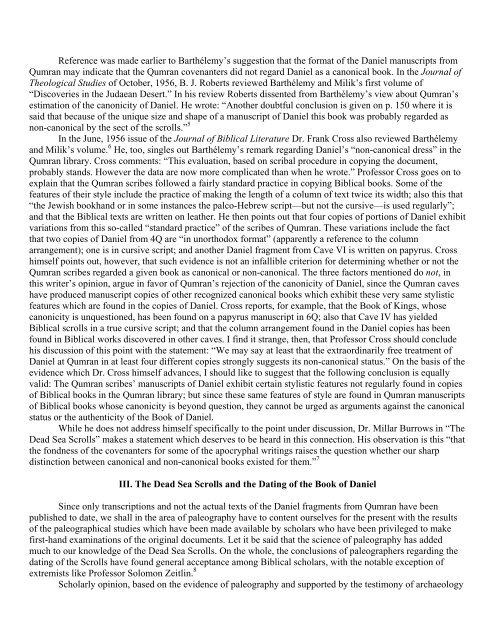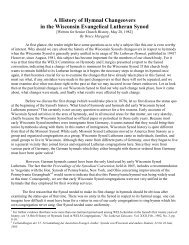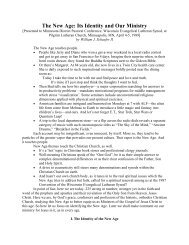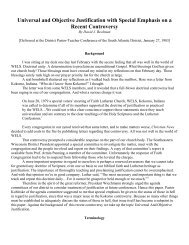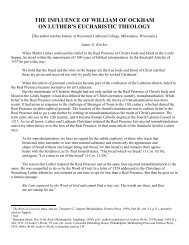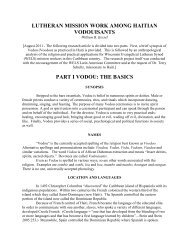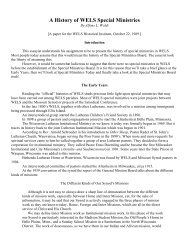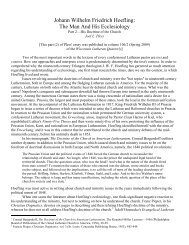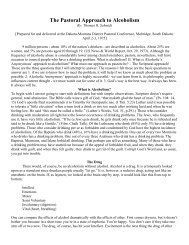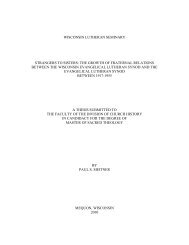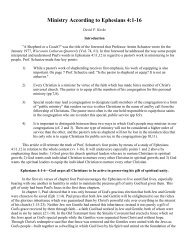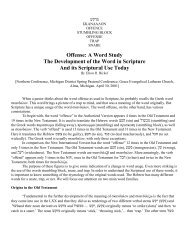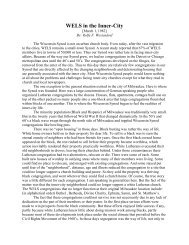The Book Of Daniel And The Dead Sea Scrolls - Wisconsin Lutheran ...
The Book Of Daniel And The Dead Sea Scrolls - Wisconsin Lutheran ...
The Book Of Daniel And The Dead Sea Scrolls - Wisconsin Lutheran ...
Create successful ePaper yourself
Turn your PDF publications into a flip-book with our unique Google optimized e-Paper software.
Reference was made earlier to Barthélemy’s suggestion that the format of the <strong>Daniel</strong> manuscripts from<br />
Qumran may indicate that the Qumran covenanters did not regard <strong>Daniel</strong> as a canonical book. In the Journal of<br />
<strong>The</strong>ological Studies of October, 1956, B. J. Roberts reviewed Barthélemy and Milik’s first volume of<br />
“Discoveries in the Judaean Desert.” In his review Roberts dissented from Barthélemy’s view about Qumran’s<br />
estimation of the canonicity of <strong>Daniel</strong>. He wrote: “Another doubtful conclusion is given on p. 150 where it is<br />
said that because of the unique size and shape of a manuscript of <strong>Daniel</strong> this book was probably regarded as<br />
non-canonical by the sect of the scrolls.” 5<br />
In the June, 1956 issue of the Journal of Biblical Literature Dr. Frank Cross also reviewed Barthélemy<br />
and Milik’s volume. 6 He, too, singles out Barthélemy’s remark regarding <strong>Daniel</strong>’s “non-canonical dress” in the<br />
Qumran library. Cross comments: “This evaluation, based on scribal procedure in copying the document,<br />
probably stands. However the data are now more complicated than when he wrote.” Professor Cross goes on to<br />
explain that the Qumran scribes followed a fairly standard practice in copying Biblical books. Some of the<br />
features of their style include the practice of making the length of a column of text twice its width; also this that<br />
“the Jewish bookhand or in some instances the palco-Hebrew script—but not the cursive—is used regularly”;<br />
and that the Biblical texts are written on leather. He then points out that four copies of portions of <strong>Daniel</strong> exhibit<br />
variations from this so-called “standard practice” of the scribes of Qumran. <strong>The</strong>se variations include the fact<br />
that two copies of <strong>Daniel</strong> from 4Q are “in unorthodox format” (apparently a reference to the column<br />
arrangement); one is in cursive script; and another <strong>Daniel</strong> fragment from Cave VI is written on papyrus. Cross<br />
himself points out, however, that such evidence is not an infallible criterion for determining whether or not the<br />
Qumran scribes regarded a given book as canonical or non-canonical. <strong>The</strong> three factors mentioned do not, in<br />
this writer’s opinion, argue in favor of Qumran’s rejection of the canonicity of <strong>Daniel</strong>, since the Qumran caves<br />
have produced manuscript copies of other recognized canonical books which exhibit these very same stylistic<br />
features which are found in the copies of <strong>Daniel</strong>. Cross reports, for example, that the <strong>Book</strong> of Kings, whose<br />
canonicity is unquestioned, has been found on a papyrus manuscript in 6Q; also that Cave IV has yielded<br />
Biblical scrolls in a true cursive script; and that the column arrangement found in the <strong>Daniel</strong> copies has been<br />
found in Biblical works discovered in other caves. I find it strange, then, that Professor Cross should conclude<br />
his discussion of this point with the statement: “We may say at least that the extraordinarily free treatment of<br />
<strong>Daniel</strong> at Qumran in at least four different copies strongly suggests its non-canonical status.” On the basis of the<br />
evidence which Dr. Cross himself advances, I should like to suggest that the following conclusion is equally<br />
valid: <strong>The</strong> Qumran scribes’ manuscripts of <strong>Daniel</strong> exhibit certain stylistic features not regularly found in copies<br />
of Biblical books in the Qumran library; but since these same features of style are found in Qumran manuscripts<br />
of Biblical books whose canonicity is beyond question, they cannot be urged as arguments against the canonical<br />
status or the authenticity of the <strong>Book</strong> of <strong>Daniel</strong>.<br />
While he does not address himself specifically to the point under discussion, Dr. Millar Burrows in “<strong>The</strong><br />
<strong>Dead</strong> <strong>Sea</strong> <strong>Scrolls</strong>” makes a statement which deserves to be heard in this connection. His observation is this “that<br />
the fondness of the covenanters for some of the apocryphal writings raises the question whether our sharp<br />
distinction between canonical and non-canonical books existed for them.” 7<br />
III. <strong>The</strong> <strong>Dead</strong> <strong>Sea</strong> <strong>Scrolls</strong> and the Dating of the <strong>Book</strong> of <strong>Daniel</strong><br />
Since only transcriptions and not the actual texts of the <strong>Daniel</strong> fragments from Qumran have been<br />
published to date, we shall in the area of paleography have to content ourselves for the present with the results<br />
of the paleographical studies which have been made available by scholars who have been privileged to make<br />
first-hand examinations of the original documents. Let it be said that the science of paleography has added<br />
much to our knowledge of the <strong>Dead</strong> <strong>Sea</strong> <strong>Scrolls</strong>. On the whole, the conclusions of paleographers regarding the<br />
dating of the <strong>Scrolls</strong> have found general acceptance among Biblical scholars, with the notable exception of<br />
extremists like Professor Solomon Zeitlin. 8<br />
Scholarly opinion, based on the evidence of paleography and supported by the testimony of archaeology


